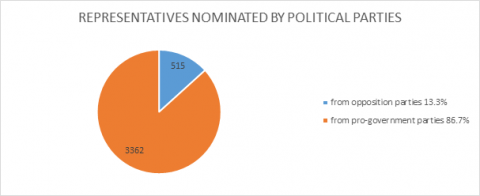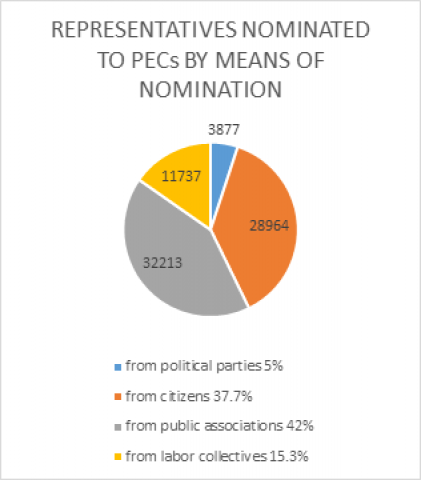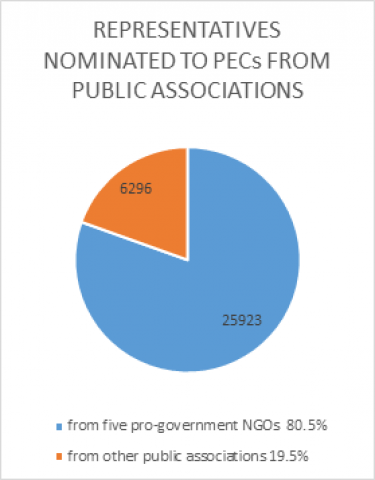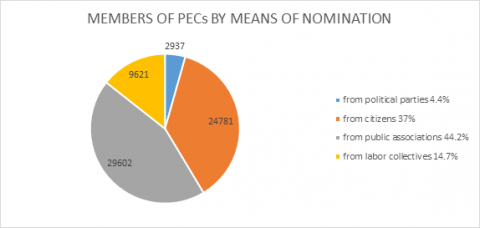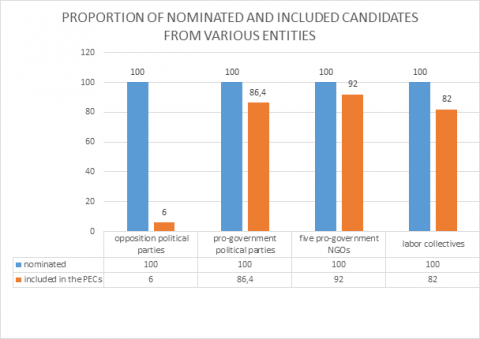Report on the results of monitoring the formation of precinct election commissions
Observation of the election of the President of Belarus is carried out by activists of the Belarusian Helsinki Committee and the Human Rights Center "Viasna" in the framework of the campaign "Human Rights Defenders for Free Elections".
1. GENERAL CONCLUSIONS
- on August 26, local executive authorities completed the formation of precinct election commissions (PECs), an important element of the electoral process directly involved in the organization of voting and counting of votes. A total of 6,080 PECs were created, and 66,941 persons became commission members.
- in general, the formation of PECs was not significantly different from previous election campaigns.
- representatives of the campaign "Human Rights Defenders for Free Elections", as a rule, had the opportunity to attend the meetings of the bodies that formed the PECs. However, there were several cases of denying access to these meetings reported by the campaign's representatives.
- meetings of the executive committee on the formation of the PECs took place in an atmosphere of relative openness, but were purely formal in nature: decision were taken without discussion of nominations to PECs, officials in the majority of cases voted for the entire list of candidates, which was drafted in advance by the executive committees; as a rule, decisions were announced within 15-30 minutes.
- in most cases, representatives of the campaign "Human Rights Defenders for Free Elections", who attended meetings on the formation of PECs, were denied access to documents on the nomination to PECs (58%).
- the formation of PECs was marked by an obvious discriminatory approach of the executive committees to the representatives of opposition parties: of the 515 activists nominated to the PECs only 31 people were included (6% of the nominated number), while of the 3,362 representatives nominated by pro-government parties, 2,906 people were included in the PECs (86.4% of the nominated number), while the commissions included 23,819 people from five major pro-governmental public associations (Belarusian Republican Youth Union, Belaya Rus, Women's Union, the Union of Veterans, and the Federation of Trade Unions (92% of the nominated number).
- the total number of members of opposition parties in the PEC is 31 people, or 0.046% of the total number of PEC members, which is five times less than in the previous presidential election.
- the absence of legally enshrined criteria for candidates nominated to the election commissions of all levels allow a selective approach to their formation. The absence of such criteria also renders ineffective a rule of the Electoral Code, which provides for judicial appeals against decisions by bodies in charge of the formation of election commissions.
2. LEGAL REGULATION
In accordance with Art. 27 of the Electoral Code, apart from the territorial election commissions (TECs), the preparation and holding of elections of the President is arranged by the precinct election commissions (PECs). The PECs are in charge of organizing voting procedures, counting and tabulation of votes at polling stations, making them one of the key mechanisms of the electoral process. At the stage of campaigning, PECs send voters information about the candidates for the President of the Republic of Belarus; controls observance of campaigning rules in the territory of the polling station. PECs consider petitions and complaints in issues related to the preparation of elections, organization of voting, counting of votes, and takes decisions on them.
Similar to the territorial election commissions, PECs are composed of representatives of political parties and other public associations, labor collectives, as well as representatives of citizens nominated to commissions by collecting signatures.
The following entities are entitled to nominate their representatives to the PECs:
- the governing bodies of regional, Minsk city, district, city, city district organizational structures of political parties, meetings of their primary-level organizations, other public organizations; the primary-level organization of a political party, other public association has the right to nominate a representative to the election commission of the polling station on the territory of which the primary organization is located;
- meetings of labor collectives of organizations and collectives of their structural divisions located in the territory of the region, city, city district, settlement and rural Council with the number of the employees not less than 10 persons;
- not less than 10 citizens eligible to vote and residing in the respective territory; an application for the nomination of a representative to the precinct election commission formed outside the Republic of Belarus shall be signed by at least three citizens residing in the territory of the precinct.
When nominating a representative to the election commission, minutes of the meeting or the application signed by the citizens shall be submitted to the bodies in charge of forming the commission not later than three days before the deadline for the formation of the commission.
PECs are formed by district, city executive committees, and in cities with district division – by local governments composed of 5-19 members.
The entities who have nominated a representative of the commission shall have the right to appeal against the decision of the relevant authority to the district or city court.
Opportunities for nominating to PECs by political parties and other public associations, as before, are limited by the requirement to possess local organizational structures. Thus, national public associations that do not have organizational structures in the regions are unable to nominate their representatives to the precinct election commissions.
3. PROCEDURE OF NOMINATION OF REPRESENTATIVES TO ELECTION COMMISSIONS
Formation of the PECs was carried out in accordance with the schedule established by the Electoral Code and the CEC’s Schedule for the organization of elections.
Information about the place and time of reception of documents was widely available on the websites of the executive committees. There were no reports on violations related to receiving the documents on the nomination of representatives by entities involved in the elections.
According to the CEC, the number of precinct election commissions reduced from 6,346 to 6,080 in comparison with the previous election. 76,791 candidates were nominated to the PECs. According to the CEC, of the 15 registered political parties in the country, 8 parties nominated their representatives to the PECs, including 4 opposition parties. Of the 3,877 party representatives, 515 (the number of representatives of the BPF is added to the number of representatives of the NGO BPF “Adradžennie”) were nominated by the opposition parties, and 3,362 – by the pro-government parties. The activities of some of these pro-government parties are totally invisible in between elections.
There were 32,213 candidates nominated by public associations and trade unions. At the same time, 80.5% of the entire number of candidates from public associations and trade unions were nominated by only 5 organizations: Belaya Rus, the Belarusian National Youth Union, the Federation of Trade Unions of Belarus, the Belarusian Women's Union and the Belarusian Public Association of Veterans.
There were 28,964 representative of the public, and 11,737 persons nominated by the labor collectives. The structure of representation in the PECs has not changed significantly as compared to previous presidential elections. The main actors of politics – political party – nominated only 5% of the entire number of candidates to the PECs.
4. MEETINGS OF BODIES IN CHARGE OF THE FORMATION OF ELECTION COMMISSIONS
The formation of the PECs was carried out in accordance with the Schedule of arrangements for the preparation of the election, and was completed by the end of the day on August 26. Information on the place and time of the meetings on the formation of the election commissions was usually available on the websites of the respective executive committees.
Representatives of NGOs and other entities who nominated their representatives to the commissions were in a number of cases invited to the meetings in advance.
The procedure for the formation of the PECs was overwhelmingly formal in its essence. Just like during previous election campaigns, the duration of the meetings of the bodies in charge of forming the commissions, was minimal in many regions covered by observation. There was usually no consideration of PECs members by executive committees and local administrations (in 88.1% of the observed cases); in 93% of the observed meetings, candidates’ personal details were not announced and their skills were not described. In particular, the meeting of the executive committee of Biaroza district lasted 8 minutes, and 489 candidates were approved; the meeting of the Hrodna regional executive committee lasted 13 minutes, and 448 PEC members were approved. It took only 15 minutes for the administration of Homieĺ’s Čyhunačny district to consider 919 candidates and include 843 people in the PECs. As a rule, executive officials voted for the entire list, which was prepared in advance by the executive committee (in 88.9% of the observed meetings).
The few exceptions were the meetings on the formation of the PECs, which took place in the administrations of the Kastryčnicki (5 hours 40 minutes) and Pieršamajski (3 hours 26 minutes) districts of the city of Viciebsk, as well as in Orša (3 hours 10 minutes). Members of the executive committees and administrations first voted for each individual candidature who was not included in each PEC, and then for the entire list of members included in the commissions. At the same, personal qualities of both included and not included candidates were not discussed, and the reasons for refusal to include in the commission were not announced.
The campaign’s representatives attending the meetings on the formation of the PECs generally did not have the opportunity to ask questions, they were denied access to documentation on the nomination to PECs (minutes of meetings, applications of citizens, 58% of cases).
The absence of clearly defined criteria still allows local authorities to form the PECs solely on the basis of their considerations.
In some cases, observers were unable to attend the meetings of the bodies in charge of forming the PECs. Representatives of the campaign "Human Rights Defenders for Free Elections", including representatives of the Belarusian Helsinki Committee, were not allowed to attend a meeting of the Žodzina city executive committee, Polack and Hlybokaje district executive committees.
An observer of the Belarusian Helsinki Committee was not admitted to a meeting of the executive committee of Viciebsk district, and later to a meeting of the administration of the Čyhunačny district of Viciebsk, but he was able to freely attend a meeting of the administration of Pieršamajski district of Viciebsk. A BHC observer was not allowed to attend a meeting of the administration of the Kastryčnicki district of Viciebsk, but at the same time he was invited there as a private person.
An official of the Hlusk district executive committee did not allow an observer of the Belarusian Helsinki Committee to attend the executive committee’s meeting dedicated to the formation of precinct election commissions, which was held on August 24. The observer learned the date and time of the meeting only half-hour before the beginning of the event.
After a meeting of the Smarhoń district executive committee on the formation of election commissions, an observer of the campaign "Human Rights Defenders for Free Elections" had the opportunity to view the documents on the nomination of candidates to the commissions. According to documentation on commission No. 6, candidates T. Vaitk and T. Shchabiaraka Subscribers were supported by the same voters, with one person appearing in two signature sheets. A senior official of the executive committee said that the observer did not have the right to inspect the documents and the circumstances he revealed did not constitute a violation.
5. STRUCTURE OF THE FORMED COMMISSIONS
A total 6,080 PECs have been formed across the country, 49 more PECs were formed at the diplomatic missions of Belarus abroad. 66,941 members were included in the domestic PECs. Thus, the commissions included 87.2% of the total number of applicants (76,791).
Candidates from five parties loyal to the current regime (the Communist Party of Belarus, the Republican Party of Labor and Justice, the Agrarian Party, the Belarusian Social and Sports Party) demonstrated results which are a little below the national average. Of the 3,362 representatives nominated by these parties, 2,906 people, i.e. 86.4% were included in the PECs. The percentage of representatives of the public associations Belaya Rus, the Belarusian National Youth Union, the Federation of Trade Unions of Belarus, the Belarusian Women’s Union and the Belarusian Public Association of Veterans who were included in the PECs was significantly higher than average: of the 25,419 representatives nominated by them, 23,689 people (92%) were included in the PECs.
At the same time, of the 515 representatives of the five opposition parties nominated to the PECs, the commissions included only 31 people, i.e. 6% of the total number. Conspicuous is the fact that during the presidential election of 2010 this figure was almost three times higher – 17.1% of the total number of applicants. As a result, representatives of the opposition parties make up as little as 0.046% of the total number of PEC members and will work in no more than 0.5% of the PECs.
Thus, obvious is the bias of bodies in charge of forming the PECs towards representatives of opposition political parties: on average, only one out of sixteen candidates from these parties won a seat in the PECs, while 9 candidates out of 10 from the pro-government parties and public associations were included in the precinct election commissions. The opposition parties are not represented in the PECs of Minsk and Mahilioŭ regions; one representative of the opposition has been elected in Homieĺ region (1,070 PECs) and one – in Hrodna region (692 PECs), two in the Minsk region (1,032 commission).
92% of representatives from the five largest pro-governmental NGOs (Belaya Rus, Belarusian Republican Youth Union, Federation of Trade Unions, Belarusian Women's Union and the Belarusian Public Association of Veterans) were eventually included in the commissions. They nominated 33.8% of the entire number of applicants and received 35.6% of the seats in the commissions.



